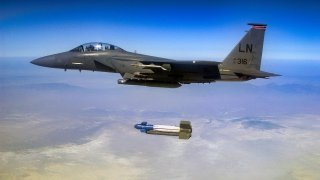AGM-130 Is the U.S. Military's Glide 'Bomb' with a Rocket
The AGM-130, an air-to-surface missile, marked a significant advancement in precision munitions. Developed from the GBU-15 guided glide bomb, it combined glide and rocket propulsion capabilities to strike high-value targets from considerable distances.
Summary: The AGM-130, an air-to-surface missile, marked a significant advancement in precision munitions. Developed from the GBU-15 guided glide bomb, it combined glide and rocket propulsion capabilities to strike high-value targets from considerable distances.
-Available in two versions, the AGM-130A targeted troop concentrations and armored vehicles, while the AGM-130C aimed at strategic structures like bunkers and command centers. Featuring an imaging infrared seeker and a data link for precision guidance, the missile was used in various military operations until its discontinuation in the 2010s.
-Originally designed for the F-15E Eagle, the AGM-130 showcased the evolution of modern munitions with its enhanced range, speed, and accuracy.
The AGM-130 Missile: Bridging Past and Present in Air-to-Surface Warfare
Modern munitions bring extremely advanced capabilities to the battlefield. They can take out small and large targets with extreme precision under any weather conditions. Some of them even come with stealth capabilities.
A great many lesser munitions paved the way to get to this point, featuring new technologies and trying out new capabilities.
The AGM-130 was one of them.
A Glide Bomb With a Rocket
The AGM-130 was an air-to-surface stand-off missile designed for high- and low-altitude strikes. The munition was an improvement to the GBU-15 guided glide bomb, and the two shared a lot of the same technology.
The AGM-130 glided like a conventional bomb until it reached a specified altitude. Its rocket then kicked off, propelling the missile to the target.
The munition came in two versions: the AGM-130A and AGM-130C. The former was designed to take out concentrations of troops and armored vehicles and had an MK-84 blast/fragmentation warhead. The latter was intended to take out high-value targets such as headquarters, bunkers, and command and control centers and had a 2,000-lbs BLU-109 penetrating warhead. A proposed AGM-130B for strikes against airfields never went into production.
With a length of almost thirteen feet and a weight of about 3,000 pounds, the AGM-130 could inflict serious damage at ranges of more than forty-six miles. The exact range of the weapons system remains classified. The speed of the munition is also classified, but it could likely reach speeds up to 600 miles per hour. The AGM-130 used a rocket motor to extend its range and an altimeter to control its altitude.
In terms of precision, the AGM-130 came equipped with an imaging infrared seeker and data link that provided the pilot with a first-person view of the target from the missile’s perspective, increasing the precision of the weapon. While the AGM-130 was in flight, the presentation from the missile to the cockpit took place through the AXQ-14 data link system. As the target came into view, the fighter could either guide the munition to the target manually or use the automatic terminal homing capability to strike at predetermined coordinates. The missile also had an internal Global Positioning System.
The AGM-130 saw active combat before it was discontinued in the 2010s. The Air Force used the missile during Operation Northern Watch in 1999 against a pair of Iraqi anti-aircraft sites, against Serbian forces during Operation Allied Force, and against Taliban and Al-Qaeda forces in the open days of Operation Enduring Freedom in Afghanistan.
The Air Force designed the AGM-130 to pair specifically with the F-15E Eagle fighter jet. The program began in 1984, and the munition went into production in the 1990s. Although the Air Force initially planned on purchasing more than 4,000 munitions, it ended up buying only a few hundred.
About the Author:
Stavros Atlamazoglou is a seasoned defense journalist specializing in special operations and a Hellenic Army veteran (national service with the 575th Marine Battalion and Army HQ). He holds a BA from Johns Hopkins University and an MA from the Johns Hopkins School of Advanced International Studies (SAIS). His work has been featured in Business Insider, Sandboxx, and SOFREP.
Image: U.S. Air Force/Flickr.


